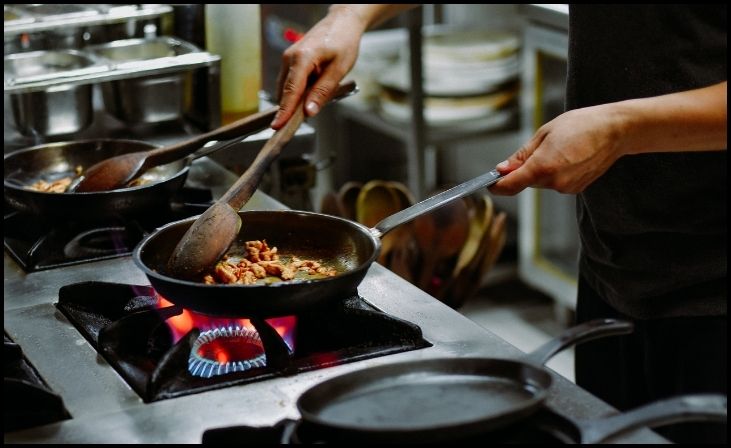Many people are unsure how to do cooking with ceramic pans. That is because the construction of ceramic pans and pots differs slightly from other cooking tools.
Isn’t it great if you could get the benefits of nonstick without using it? A ceramic-coated pan is a nonstick, environmentally friendly alternative to traditional cookware.
Ceramic pots and pans have a chemical-free coating that makes them lightweight and attractive. In addition, there was a coating that could make cooking as effortless as your preferred nonstick.
Although ceramic pans aren’t a new concept, we can now get high-quality cookware that is both functional and long-lasting.
These nonstick pans are excellent for many kinds of stoves, although they require a little more care due to their unique qualities. They can, however, distort or lose their finish if not properly maintained.
This article shows you how to cook with ceramic pans and what considerations you should make so that you get the most from your ceramic pan.
For More Cookware Check Types of Pots and Pans Guide.
How To Cook With Ceramic Pans

Ceramic frying pans must be used in a specific way. You can’t just take the pan out of the cupboard and start cooking. You’re more likely to damage the pan’s ceramic coating or completely ruin it.
So, if you want to learn how to do cooking with ceramic pans, keep the following tips in mind:
Do’s
Clean the pots before use
When using a ceramic pan for the first time, you should thoroughly clean it. Before cleaning the pan properly, soak it in warm water.
First, use warm, soapy water to wash it. Finally, dry the pan with a dish towel, and you are done.
It is necessary to remove any dust or other chemicals that may have come into contact with the pan.
Use butter or oil when cooking
When cooking in ceramic, you’ll need less oil or butter than when using other cookware, but you shouldn’t cook on a dry pan surface.
Before you begin to cook, add a tiny bit of butter or oil; around a tablespoon should enough.
Use low to medium heat
Always use low or medium heat when using a pan with a ceramic covering because ceramic pans are excellent heat conductors. The ceramic pans can be severely damaged if they are left on high heat for an extended amount of time.
Furthermore, Do not leave your pan alone; even when preheating, it is necessary to keep an eye on it. Over medium-low heat, this pan is ideal for gradually cooking veggies, and food will cook evenly.
Properly season the pan
Although Seasoning is not required for Ceramic pans, for some it may vary.
They must be seasoned before use and then once or twice a year. To season your pan, perform the following steps:
- First, carefully rinse and dry the pan.
- Apply one tablespoon of cooking oil, place the pan in the oven, or heat it on the stove.
- Preheat the oven to 250 degrees F and bake the pan for 3 minutes, or Heat the pan on medium heat for 3 minutes on the stovetop.
- Allow cooling after removing the pan from the heat.
- Wipe any remaining oil with more tissue paper.
Store your pans properly
Cookware that is stored properly will last a long time. Before storing your pots, make sure they’re clean. Keep ceramic pans separate from the other cookware.
Ceramic can be destroyed if it touches other cookware made of the same material. Ceramic protectors are also available, which reduce the chance of the coatings being scratched.
Don’t
Avoid using cooking oil sprays
Never use cooking oil sprays to coat ceramic pans. Other compounds in aerosol sprays can tear down the ceramic coating. They also leave a layer on the pan that is difficult to remove.
Using virgin olive oil will result in the pan getting carbonized and burning on high heat. Instead, Coat the ceramic pan with a bit of butter or oil.
Avoid using metal utensils
Metal utensils should not be used since they can scratch the exterior layer of ceramic cookware. The coating on the pan will disintegrate as it is scratched, and the pan’s utility will degrade.
Instead, use silicone or wooden spoons and spatulas to prepare your food.
Do not use harsh abrasive chemicals during cleaning
Ceramic pans are a little more fragile, and powerful chemicals might destroy their coating. Avoid using steel wool soap pads, scouring powders, and nylon cleaning pads.
Using a non-abrasive sponge and warm, soapy water, clean a ceramic pan. Afterward, wipe it clean or let it air dry fully before putting it away.
Do not put a hot pan in cold water
Before rinsing, make sure the pans are totally cool. Cold water sprayed on a hot surface can harm the coating and cause the pan to deform over time.
You can avoid all of this by allowing it to cool down.
Avoid putting in the dishwasher
Hand washing is the most effective method for cleaning your ceramic pan. Handwashing will keep the coating in place for many years.
Many ceramic pans aren’t dishwasher safe. They may lose their coating, and poor washing may result in scratches on the surface.
Hand washing is simple and quick, and soapy water is usually sufficient to clean the pan.
Why Ceramic Cookware Good For Your Health?

These pans are well known for their numerous benefits, and those who have used them have become lifelong fans.
In addition to their versatility, You can use them for baking, steaming, grilling, toaster ovens, and convection cooktops.
Follow this care advice to keep your ceramic pans in great shape. You’ll be able to use your ceramic pan confidently once you’ve figured out what to do with it.
The Benefits Of Ceramic Cookware
- Non-reactive: Ceramic comes in various colors and thicknesses. It is non-reactive. That means you can cook acidic things in it without fear of anything leaching into your food.
- Heat transfer efficiently: Ceramic coated pans are usually constructed of aluminum; heat transfer is quick, uniform, and efficient, allowing you to cook your food with less energy.
- Nonstick: One of its most important characteristics is that it is nonstick. Ceramic is smooth, and all you takes to keep food from sticking to it is a little oil or butter.
- Lightweight: The lightweight pan is made possible by combining an aluminum base and a ceramic coating.
- Heat resistant: When compared to other cookware materials, its capacity to endure high heat gives it an advantage. Cookware made of ceramic can withstand temperatures of up to 450°C.
- Easy to clean: The nonstick surface prevents food from adhering, making cleanup effortless. Hand washing is recommended, normally requiring only a tiny amount of mild dishwashing detergent, warm water, and a wipe with a paper towel or cloth.
How to Care for Your Ceramic Pans
- Allow the pan to cool completely before using. Never soak a heated ceramic pan in cold water.
- Wash the ceramic cookware in warm, soapy water. Remove all food particles from the pan with a sponge or a clean dishcloth.
- Wipe both the interior and outside of each pan’s cooking surface.
- Using clean water, thoroughly rinse the pan.
- Examine the pan for any food particles that may have gotten stuck.
- Once the pan is clean, dry it.
Conclusion
You may learn how to do cooking with ceramic pans and avoid many of the problems by paying attention to the recommendations provided here.
It may appear that using ceramic pots and pans is difficult, but it is not. All you need is some guidance and additional ideas to keep them in good shape for longer.
These instructions are designed to keep the coating in good condition.
If you want to buy another material type and are confused about what to buy check the cookware material guide.
Frequently Asked Questions
When cooking, use low or medium heat to help preserve the coating; high heat will quickly degrade the coating’s nonstick characteristics.
Cookware made of ceramic is naturally nonstick. It’s a long-lasting material. It can be used in the oven, microwave, or cooktop. Because of its natural nonstick properties, the food releases easily and rapidly.
A lightly scratched ceramic pan can be used, but minor scratches indicate that your pan will need to be replaced soon. The scratches degrade the pan’s nonstick properties, causing food to adhere to it.

Leave a Reply